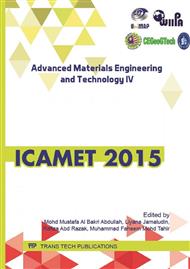p.58
p.63
p.68
p.73
p.76
p.79
p.83
p.87
p.93
Wettability of CNT-Doped Solder under Isothermal Aging
Abstract:
Wettability for lead free solder 99.0Sn-0.3Ag-0.7Cu (SAC237) with addition of different weight percentage carbon nanotube after thermal treatment was investigated. SAC 237 solder powder with flux was mixed with 0.01%, 0.02%, 0.03% and 0.04% carbon nanotubes (CNTs) to form SAC-CNTs solder paste. Printed solder paste on test board with Cu surface finish was then reflow under 270°C temperature and isothermal aging at 150°C for 0,200 and 400 hours. Wettability of SAC-CNT solder was determined by measuring contact angle using optical microscope and image analyzer. As a result, from reflow process right through 400 hours of thermal aging, SAC237 with 0.04% CNT has the lowest contact angle as compared to other SAC-CNTs and SAC237 solder. As a conclusion, addition of carbon nanotubes into solder SAC237 improved their wettability on Cu substrate, especially at 0.04% of CNTs.
Info:
Periodical:
Pages:
76-78
Citation:
Online since:
May 2016
Authors:
Keywords:
Price:
Сopyright:
© 2016 Trans Tech Publications Ltd. All Rights Reserved
Share:
Citation:


